At the end of this month, I will attend a public event called TimeWorld 2022 Paris, that is dedicated to discussions on challenging questions between industrial actors, scientific researchers and the general public. As can be seen on the conference website, it consists of about 100 conferences, some round tables and the event is also a place for artists to show up their art.
The topic of this year is about construction, and it is focused on a variety of topics including science (and in particular physics, of course!) as well as finance, cryptography, economics, literature, arts, etc. In fact, many topics that could be of some interests for Hive community members.
I have been invited to discuss the general context of my research during this event. Embedded in the theme of this year (i.e. construction), I plan to provide hints to build an answer to the question raised in the title of this blog: do we still need to build models beyond the Standard Model of particle physics?
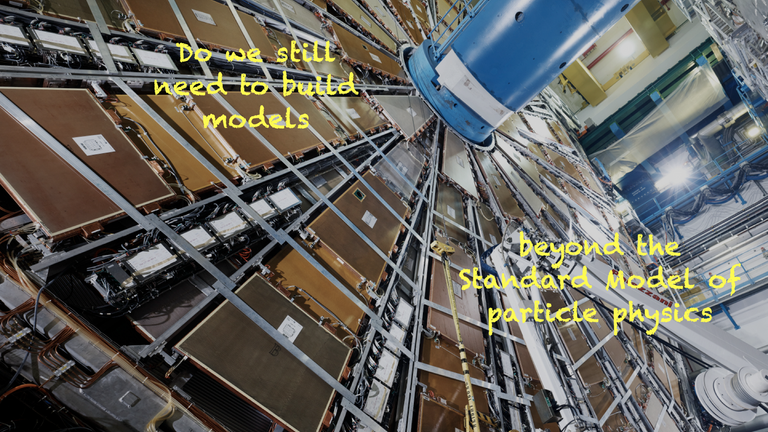
[Credits: Original image from ATLAS @ CERN]
Whereas I can tell you that the answer to that question is positive, this is something that could have been guessed by those reading me, week after week. It is clear that in the case of a negative answer, I would have stopped writing on this topic for quite a while already (and I would have probably changed job too)…
For the first time since I joined this chain almost 6 years ago (40 days are left before my Hive birthday ;) ), I decided to use my blog on Hive to provide an expanded summary/abstract of my talk at TimeWorld, and share it on Twitter (that is one of the media used by the organisers to advertise the event). Could this be a way to increase my audience off-chain, and attract new users on Hive? I don’t know the answer to that question, but I would like to try it out. We will see!
To finish this short introduction, if you are by any chance in Paris on June 29 - July 1st, feel free to let me know and pass by the event! From now on, in the rest of this blog it is time for science!
The Standard Model of particle physics - the starting point
Before discussing whether it is needed to go beyond the Standard Model of particle physics, it is instructive to start with a summary on what the Standard Model of particle physics is. I wrote a few blogs about this topic a while ago (see here and there, for instance), so that in the following I really focus on a summary. I know that I am not good in writing in a compact way. Let’s see how I can manage such an exercise…
So, what is the Standard Model of particle physics exactly? In one line, it consists of a theoretical framework describing how matter works at its most fundamental level. This includes details about the constituents of matter, and how they interact with each other. Moreover, the fact that the Standard Model is a theoretical framework means that it can be tested through predictions to compare with data.
In order to understand how the Standard Model has been built, we must go back to the end of the 19th century. This consists of the moment at which Lord Kelvin said that ‘there was nothing new to be discovered in physics, and that all that remained was more and more precise measurement’ (see also here). Luckily for us, he was very wrong on this, so that physics is by far not a boring field (at least for physicists)!
Almost 30 years later, physicists had discovered (among others) that all atoms were made of protons, neutrons and electrons, that the microscopic world was quantum, and that certain radioactive decays yielded the production of an invisible particle called a neutrino.
Four particles and … there was possibly nothing anymore to be discovered in physics again. There was no more Lord Kelvin at that time, but it is today clear that his quote was still very wrong…
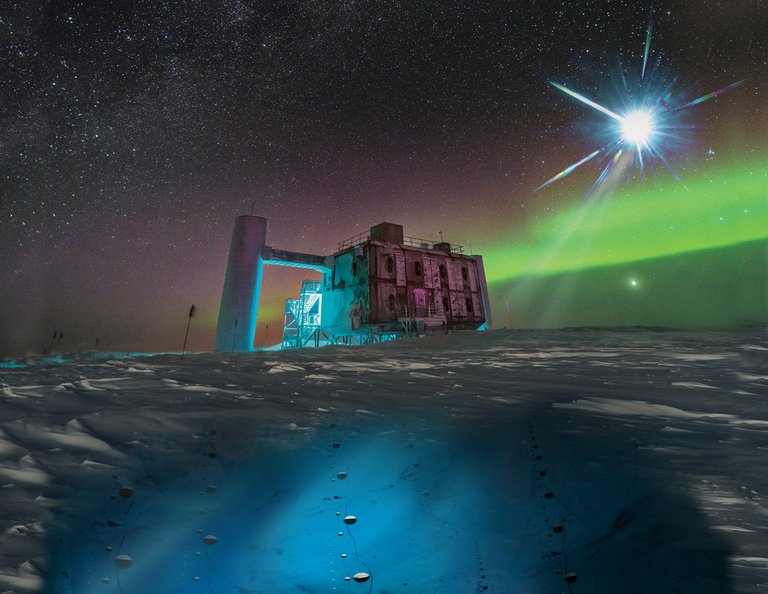
[Credits: IceCube (NSF)]
In the next 20 years, many challenging observations were made. In particular, weird particles were observed in cosmic rays (the detectors of that time were simple photographic plates), as well as in the outcome of the first particle collider experiments (like at CERN’s Large Hadron Collider, but in a not so large and less energetic version).
Those weirdos made our understanding of nature very messy, and we ended with dozens of new subatomic particles mostly characterised by fancy Greek names: 𝜋’s, K’s (beware as this one is not Greek), 𝛺’s, 𝜮’s, 𝜩’s, 𝜔’s, 𝚫’s, 𝜇, 𝜈e, 𝜈𝜇, etc.
Physicists needed to understand how to order this zoo. This is precisely how the Standard Model has been built in the 1960s-1970s.
Quarks, leptons and the fundamental interactions
It took a few dozens of extra years for physicists to replace all this zoo of particles by a table including only a few elementary particles.
The cornerstone of the approach is to say that all particles discovered in the first half of the 19th century were composite particles. These composite particles are thus made of a small number of elementary entities coined quarks, that can combine with each other thanks to one of the three fundamental interactions called the strong force.
Initially, the proposed model was made of 3 quarks, but we know today that nature includes 6 of them: the up quark, the down quark, the strange quark, the charm quark, the bottom quark and the top quark.
As a side note, the top quark is the heaviest of all known particles, so that whereas it has been proposed in the 1970s, we had to wait until 1995 for its discovery. Heavy stuff is hard to produce, and this stays very true those days.
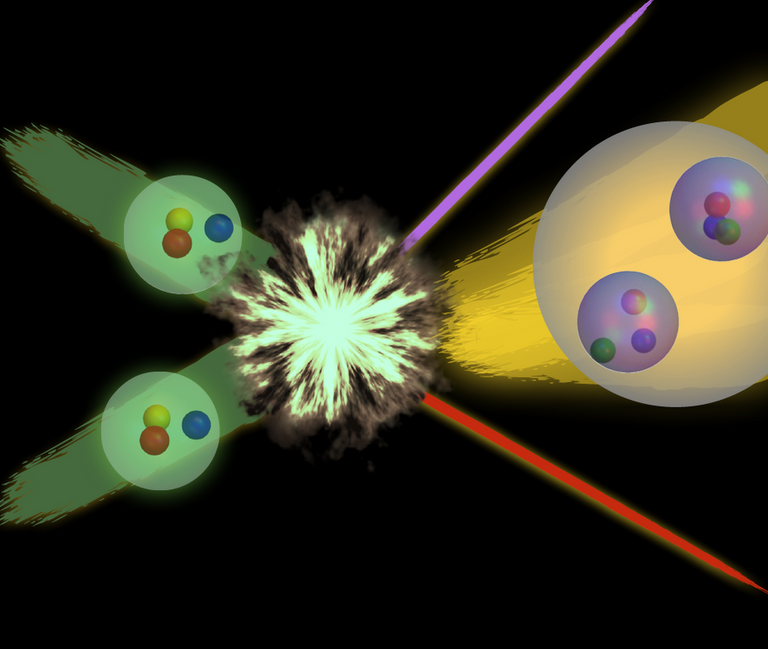
[Credits: OLCF (CC BY 2.0)]
On top of these 6 quarks, the Standard Model includes 6 elementary particles that are not sensitive to the strong force. These are named leptons.
Leptons include three electrically-charged beasts (the electron, the muon and the tau) and three electrically-neutral invisibles (the electron neutrino, the muon neutrino and the tau neutrino). All of these have been observed and discovered today, the last neutrino requiring a donut for its discovery (@riverflows: running jokes are never bad).
In addition to the strong force that we already mentioned, the Standard Model describes two others fundamental interactions: electromagnetism and weak interactions. The three interactions form the theory framework that dictates how elementary particles live, drink and dance.
Through the concept of gauge symmetries, interactions can be seen as exchanges of force carriers that include photons (electromagnetism), W-bosons and Z-bosons (weak interactions), and gluons (strong interactions). Such a principle underlying these gauge symmetries works extremely well, as demonstrated by hundred years of data.
However, there is a small issue. Whereas gauge symmetries are successful in describing how the world functions at its fundamental level, they require all matter and all force carriers to be massless. This of course contradicts experimental results.
One Higgs boson to rule them all!
As we don’t want to use the bin for a theory that worked so well, physicists came up with a way to keep the concept of gauge symmetries whilst providing masses for all elementary particles. This is what we call the Brout-Englert-Higgs mechanism (that carries the name of those who proposed it in the 1960s).
To explain how it works, I like to use the image used in the Nobel prize press release:
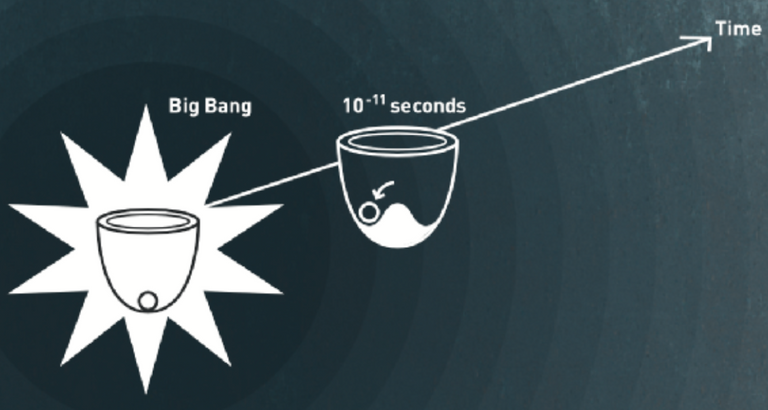
[Credits: Nobel Prize]
Let’s travel back in time, when our universe was super young (i.e. that’s right after the Big Bang). We can see ourselves as the ball in the bowl in the image above. The full picture is symmetric in the sense that it can rotate around the vertical axis without undergoing any change.
In other words, in the early universe nature is gauge-symmetric. If we push the ball a little bit away from the centre of the bowl, it goes back where it was. Gauge symmetries are there, stay there, life has no mass (and too bad for it!).
A tiny moment later (at 10-11 second after the Big Bang to be precise) something happened. A bump rose at the centre of the bowl, which corresponds to the so-called electroweak phase transition. The reason behind this motivates many present studies. Why did it happen? That’s a problem that will hopefully be solved within my lifetime.
This bump makes a lot of differences. If I now push the ball away from the centre of the bowl, it falls and does not come back anymore to the centre. Whereas the symmetry is still there (we have a bumpy bowl that can rotate on itself and stay unchanged), the fact that the ball is away from the centre hides it. From the perspective of the bowl+ball system, the symmetry has been broken.
This is how particles get masses. Nature is gauge symmetric, but it has chosen a direction (i.e. a way to fall from the centre of the bowl) to hide this symmetry. The fundamental particles get massive in the process. Technically, we say that the gauge symmetries are spontaneously broken.
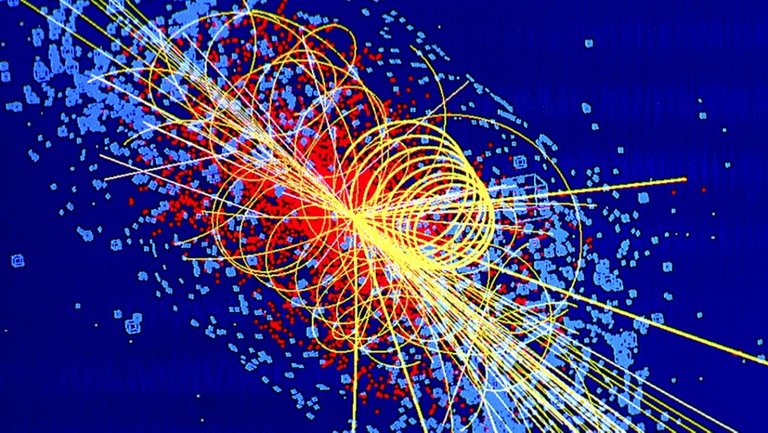
[Credits: CERN]
The price to pay for this mechanism to be realised lies in its remnant, one new particle called the Higgs boson, and that has been observed exactly 10 years ago (on July 4th 2012).
We have thus discovered all the fantastic beasts of the Standard Model. However, we still do not know today whether the Higgs boson has the right properties. We may need more than 100 years of future data to be able to answer that question.
Particle physics is thus not over, despite of Lord Kelvin (who is therefore still very wrong)…
Going beyond the Standard Model?
We are now ready to (finally) try to provide an answer to the question raised in the title of this blog.
Whereas the Standard Model itself is not complete (this word is used by many physicists, and I strongly disagree with anyone saying that the Standard Model is complete), there are very good other reasons to see it only as the tip of the iceberg.
The Standard Model is plagued by many conceptual issues and practical limitations. It is consequently clear to most of us that it must be embedded into a more fundamental theory yet to be discovered. But why are physicists certain about this?
First of all, in the Standard Model the three neutrinos have no mass. We however have observed that neutrinos change nature while they travel. For instance, an electron neutrino produced at a given place in the universe could be detected on Earth as an electron neutrino, a muon neutrino or a tau neutrino on Earth. All three options are possible (with different probabilities).

[Credits: CERN (CC BY-4.0)]
In order for this phenomenon to be possible, neutrinos must be massive. This requires to extend the Standard Model, and there are various ways to do it. Each possibility comes with some new particles and new (potentially) observable phenomena, as detailed a bit more in this blog.
In addition, if we consider the standard model of cosmology that provides the best fit to cosmological data, then the universe has to be full of dark matter. And by full, I actually mean: ‘full’. 85% of all matter is indeed expected to be dark.
If we now make another assumption, and enforce that there is a dark matter particle, then we have a problem. There is no such a dark particle in the Standard Model, that must thus be extended. Doing so makes the theory full of new particles and phenomena. However, we do not know much about the nature of dark matter, so that hundreds of possibilities are available.
Here the (experimental) difficulty is clearly not to miss any, especially as any possibility offers several ways to search for dark matter. We therefore must be pragmatic, and (try to) explore all options. Not finding anything in spite of numerous searches is fine. Missing something because there are unexplored possibilities would be catastrophic.
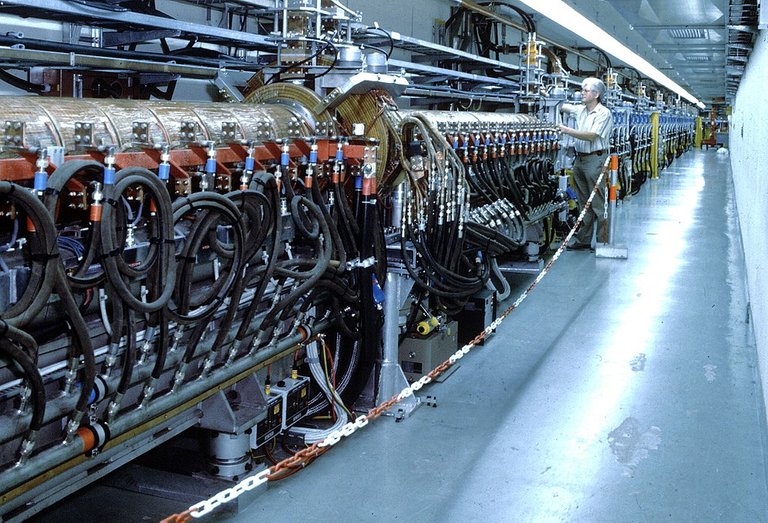
[Credits: CERN]
This is not all. On a more theoretical side, we solved the problem of the particle masses with the Brout-Englert-Higgs mechanism. Therefore, the Standard Model masses, and in particular those of the W and Z bosons, are related to the properties of the Higgs boson. Let’s now see why this is a problem.
In the Standard Model, all parameters are interconnected through quantum effects (because the microscopic world is quantum). As a consequence, parameters of the theory have to be fixed up to their 30th digit to make sure the theory does not collapse.
In particular, we must guarantee that the W, the Z and the Higgs boson all have masses in agreement with data. This enforces us to make sure that the mass of the Higgs boson is not sent to 100,000,000,000,000,000 times its value. This is actually what we successfully achieve by fixing those 30-figure number.
This is highly non-elegant, and makes us thinking that there must be some stabilising mechanism hidden behind the scene. This triggered a lot of development of beyond the Standard Model theories, and each potential solution comes with a bunch of new particles and new observable phenomena.
Again, this shows us that Lord Kelvin is still wrong today… Physics is not done!
I could continue and ask many more questions. For instance, why does the Standard Model include (about) two dozens of free parameters. Could all known particles be organised so that they could be different facets of a single object? How could gravity be embedded in the Standard Model? Where is antimatter gone? And so on…
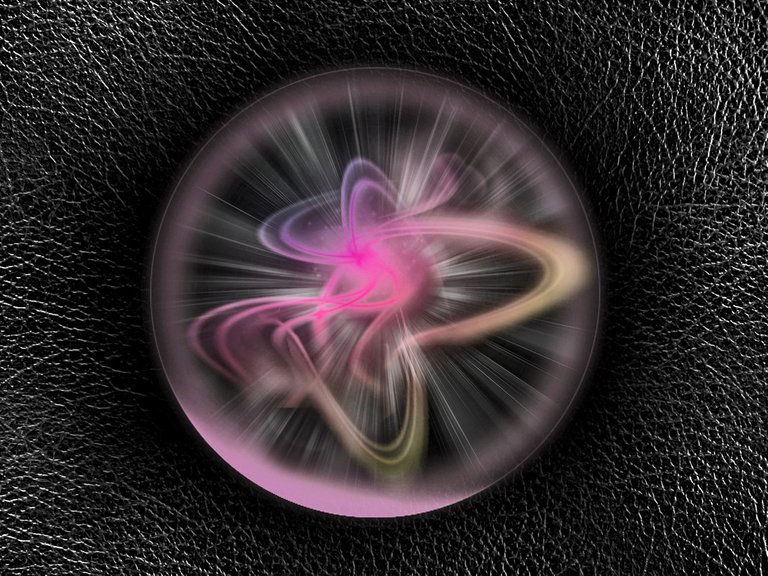
[Credits: ThomasWolter (Pixabay)]
To conclude: YES! We still need to build new models!
The Standard Model is the current paradigm explaining how fundamental particles play, dance, sing and get wild. Whereas this theory has been built following the discoveries of the last hundred years, physics is still far from being done (hi Lord Kelvin…). Every decade, new observations appear and challenge our understanding of how our universe works, which opens the door to new theoretical and experimental developments.
The Standard Model is thus only the tip of the iceberg. Whereas it works like a charm, many questions are still unanswered, and many puzzles still wait to be solved. For these reasons, physicists usually pick their favourite questions/issues and build (often varied) theories aiming at providing an explanation to them. Generally, this comes with a bunch of new phenomena and particles that could be observed in present and future data. Doing so will help us to sharpen our vision of the microscopic world.
So far, our searches for new phenomena have found nothing. However, this is not a big deal, because we explore how the universe could and could not function. There is no guarantee to find anything behind the corner (although we all agree that this would be amazing), and we may need to push our searches a little bit further. Isn’t it precisely what is exciting: probing deeply the unknown?
I will stop writing for now. For more information, feel free to ask questions in the comments to this blog, or to join me at TimeWorld 2022 at the end of the month. I promise, my speech will include many (physicist’s) jokes!
Hello @lemouth,
It is quite exciting that you have been invited to the TimeWorld 2022 Paris conference. What an honor, and how exciting. I looked at the website for this event. It is the sort of event where, at another time and given different circumstances, I would be most comfortable. All those different disciplines (I hate that word) coming together, like a picnic :)
As for your blog today...it is a perfect summation of the development of the Standard Model and the direction of current research in particle physics. There are certain junctures in your summary that I find particularly fascinating, for example the 'bump'.
It's almost like a second Big Bang. Why did it happen? This opens the door for explanations that might be more mystical than physicists might entertain.
I am not inclined in that direction, but the door is open to speculation as long as these mysteries, the "spontaneous" ruptures exist.
Have a wonderful, rich experience at the conference. I hope the symptoms of your COVID bout have cleared. My daughter is back at work, but very tired.
Take care....
I am quite excited too. My talk is now ready (I have just finalised the slides, that are in French but I can translate them if you are interested). I am looking forward to this event, that is happening very close to my office :)
I was actually sure this was the kind of event that you may enjoy. There was one organised in Montreal last May, which is a bit closer to where you live. I do not know where the next one will be organised (I will let you know if it will be in North America)
You can look at "electroweak phase transition" to get a taste of this. There are many proposals for an explanation, and all of them have testable consequences (new phenomena and new particles).
I thought I was better and started to live as normal again. I am paying a hard price for this since yesterday... I am exhausted again, and this time I have no option to rest... Damned COVID... :(
I am so, so sorry. You must listen to your body. I think your wife must be frustrated and worried about you. Protect yourself, @lemouth. This is a nasty, nasty virus. Yes, Damned COVID. Rest is an investment in yourself and your future. It's not wasted time. It's invested time.
As for the the conference. Precisely because of COVID, I don't go out in crowds at all, and when I am around people I wear a high-quality mask. There is a sense of time wasted, years now, but I am productive although sheltered. As you know I am 75!! Also, I take immune suppressant drugs to control an autoimmune condition. So, I am very high risk. Being productive and enjoying life, but staying away from possible sources of infection is my strategy. If I catch it (it seems unavoidable, doesn't it?) then I'm in for a fight.
So, I will read about the conference. I think I can read your slides in French. Somehow I am able to sort most Romance languages (read them, with effort). Years of studying Spanish in school and listening to relatives speak Sicilian when I was growing up might be the reason. If there were a way to virtually attend the conference, I would do that. My granddaughter is graduating this Sunday and it is being live streamed. So, in a sense, I will be there. Afterwards, we meet outside in the backyard.
Life, with COVID.
Please take care of yourself. It's the best investment you can make.
Warm regards....
My wife being a nurse, she is even very angry about me not listening to both her and my body. I however plan to enjoy the week-end, offline.
You should definitely be careful. And this may not be sufficient. I got COVID at a conference, wearing a mask, paying attention, etc. It didn't prevent the virus to find me. We should not underestimate how nasty this little beast is...
As the organisers may ask me for an English version soon, both a French and an English version may become available very shortly. In the meantime, here is a link to the French version of my slides. Note that there is a part that I have not covered in my post, as it is good to keep some surprises for those who will actually come to listen to me. ;)
Have a nice week-end (a little bit in advance)!
I love the slides. The illustrations are lovely, and clear. I did not read all of them yet, but so much of what you present you have discussed here and the science vocabulary is fairly consistent. Thank you so much for the link. I look forward to reading these as I go to sleep (on my iPad). They will be very relaxing.
As for your COVID fight: no one loves you more than your wife. She is smart, a health professional. It's hard (I never listen to my husband 😆), but listen to her on this one. Life is precious, and more fragile than most of us realize.
Enjoy your weekend offline. More sun, more vitamin D.
Take care, @lemouth.
Hehe! We had a nice week-end, although with a so so weather. How was yours?
From today, I am better from the COVID stand point, but stiff neck finished me... Yeah.... my body seems to be falling into pieces... I am happy to have my wife to take care of me :p
I am so happy to hear from you. Worried 😇
Yes!!!
I think that is all part of the virus. It is fighting you. You fight back. Rest.
We are OK here. My granddaughter's graduation yesterday made me proud (I watched it online!!!!) but saddened me. Time passes. Hard to accept the end of an era. We spent a lot of time together.
Take care of yourself🌞
I deeply appreciate your succinct and forthright explanation of the Standard Model in layman's terms. I hope your presentation achieves all your goals for it. I have great reticence in sharing my rude grasp of physics as an unlearned layman, but I seem to understand gravity differently than I have heard expressed by anyone I have read more extensively. From Einstein's description of gravity as the warping of spacetime I note that gravity is not a force anymore than volume is a force. Dropping a stone into a pond results in pressure on the water to move to accept the volume displaced by the stone, and similarly mass affecting spacetime produces warping as a result, and neither volume nor gravity are forces per se, although producing affects involving forces.
Since gravity affects spacetime, which is neither space nor time, I understand it's affects to extend across the full breadth of that medium, and it seems to me that dark matter is proposed to account for the affects of matter at other times that is not apparent presently in the visible space.
This does not accord with the standard model as I understand it, and I am incompetent to even contemplate treating this understanding mathematically. Frankly I can count past twenty if I am without pants, so am curious if my understanding has any basis in such facts as you believe demonstrable, or if it is contradicted.
Thanks!
Here, one important point to keep in mind is that I discuss particle physics. This means that our problem lies in the context of the elementary particles and their interactions. Gravitational effects are here tiny, as they are proportional to the masses involved. Elementary particle masses are indeed so small that anything related to gravity is negligible compared to the effects associated with any of the other three fundamental interactions. This obviously change at super high energies, much higher than anything we can conceive as humans (we are talking about a factor of 1015 more or less).
In addition, we do not know how to include gravity in the Standard Model, and this lies at the heart of many on-going researches today. But for anything that concerns us, this problem is a non problem (as whatever is the way gravity will be incorporated to the Standard Model, it will have a non-measurable effect on any observable).
As a side note, we cannot really discuss "volumes", because this does not involve time. Gravitational effects of massive bodies act on all four dimensions of space time, according to general relativity.
Gravity is a force in the context of mechanics. On the other hand, general relativity tells us that this force is not an ordinary force.
At the end of the day, what matters is the context. For slowly moving and not too heavy objects, Newtonian mechanics is a very good approximation, with its context of forces, acceleration, etc. Otherwise, we need to rely on relativity in which what we interpret as a force is the curvature of spacetime. This seems to agree with what you wrote, if I got it correctly.
I don't understand the above paragraph. Why do you say that there is no dark matter in space today? If we assume that the standard model of cosmology is valid, with dark matter in it, then we can explain varied cosmological observations (galaxy rotation curves, the cosmic microwave background, structure formation, etc., to quote a few of them). Do you therefore mind clarifying your comment? Thanks in advance!
Cheers, and thanks again for passing by!
Posting this on behalf of @valued-customer who contacted via discord
Across spacetime masses warp the medium when and where they occur, but mass warping spacetime is not either constrained in it’s extent of affect in time nor space, because it warps spacetime, not only space, and decreases in affect according to the inverse square law at all distances. The affect is across both space and time because spacetime is what exists, not space and time as separate entities. Thus, although observing the affects of mass on space is all we can do, because we perceive time as an instant and do not observe vectors across time as we observe them in space, mass effects spacetime warping, not merely spatial warping. We see space extensively, but only perceive time as an instant. I can see across a valley, but not a century. However the masses at other instants of time in spacetime do affect the spacetime we observe spatially, and instantly, and this is unaccounted for in the reckoning of the affects of the masses we observe spatially, because we do not observe the mass at other times.
We perceive reality as a point in time, but a field of space. Were we to observe vectors through time rather than as motion through space, we would see flashes of mass appearing and vanishing at one spatial point across time, a variable brightness rather than a streak across the sky.
Seems to me this failure to reckon the extent of mass in time is the reason the vast majority of mass in the observed space seems to be invisible, because the vast majority of mass warping spacetime is invisible, because it is warping spacetime across the spacetime continuum, and not only in the instant we perceive it. That is accounted as dark matter, IMHO. At least it is not accounted for otherwise AFAIK, leaving the vast majority of gravitational warping unnaccounted for.
Spacetime is infinite, and the warping of spacetime extends across that field, both at instants forward in time from us, and instants backwards in time from us. The warping of spacetime observed is actually due to the gravity from all mass that has ever, or will ever, exist everywhere, and not merely the mass that is instantly observable at present.
There is much more to what we look at than we see.
@valued-customer: I am still not sure to really get your point here. I will however try to answer anyway. I hope not to be too off-topic.
Initially, dark matter was postulated to explain why the observed circular motion of stars in galaxies as a function of their distance from the galactic centres was faster than what was obtained with Newtonian mechanics only. In other words, there was some invisible mass leading to the observed effect. This observation requires measurement of times and distances, and this was done without any problem at all.
Similarly, we can assume the standard model of cosmology (with dark matter and dark energy) and fit all data we have. It works out of the box, in particular when focusing on the cosmic microwave background. Furthermore, we can simulate structure formation in our universe. Again, the observed pattern can nicely be explained in standard cosmology (with dark matter).
Now (what follows seems closer to what you pointed out), we can also discuss gravitational lensing that is a general relativity effect due to the distortion of spacetime. What we observe agrees both with general relativity and the assumption of dark matter.
To finish, I would like to comment on this:
There is no proof spacetime is infinite. It may actually not be.
What is true is what we observe today is a picture of some part of the universe as it was in the past (as light takes some time to reach us). I however don't see why we could not account for this in calculations (and in fact we do account for it).
Point taken. However, that does not change what appears to be the fact that spacetime is affected by all mass that has ever or will ever exist everywhere, and which seems to not be accounted for in extant calculations in the standard model. As I understand it only the mass that is observable by us instantly, whether at hand or removed at some distance that imposes a time delay due to light taking time to reach us, is accounted for. All the mass that exerts it's warping effect on spacetime is not reckoned, because only what we observe in the instant of observation is accounted.
What I propose is that mass we do not presently observe and have not accounted as warping spacetime does warp spacetime, and the proposal that there is some form of mass that only exerts gravitational warping, dark matter, is therefore unnecessary. That mass not observed at the instant of observation, whether what we observe is now present or has been present at the time in the past the speed of light reveals to us now, is the mass our reckoning of the warping of spacetime, gravitational lensing, indicates is not observed.
Proposing dark matter (and dark energy) is therefore unnecessary, and that dark matter proposed to account for the observed warping of spacetime is substituting for the mass that effects gravitational lensing we do not observe at the instant of observation but that certainly has and will exist and affect spacetime at the instant of observation.
I am very confuse, when you wrote this:
This is precisely a definition of dark matter, isn't it? I actually don't understand the difference.
PS: dark energy is different as this is the engine that allows the universe to expand in an accelerated way.
Dark matter as I understand it's description is proposed to comprise of WIMPs, weakly interacting massive particles, which have properties specifically that do not otherwise interact with other matter than gravitationally.
That is not ordinary matter at other times. That is additional and vastly different matter than ordinary matter at other times. Dark matter has properties that make it invisible, while ordinary matter at other times is simply not observable because we perceive time as an instant, and have not understood the nature of spacetime with which ordinary matter interacts.
What I discuss is that mass that existed yesterday, and all days before yesterday, is affecting spacetime today, and mass that will exist tomorrow, and all days after tomorrow, in addition to all mass that exists today, is affecting spacetime today. Ordinary matter that we observe today but are not observing at times past nor times to come is what is invisible and not accounted in the calculation of observed spacetime warping, gravitational lensing, we observe at the time of observation.
Mass affects spacetime. There is no place from which the affect of mass does not reach a given region of spacetime (except perhaps within the Schwarzchild Radius of a black hole), and this means there is no era in which mass has existed or will exist in which it does not affect a given era of spacetime, including the specific instant in which we are observing spacetime warping. The inverse square law governs the degree of affect mass has on spacetime, and reduces the amount of warping mass will effect the more distant mass is from the spacetime being warped, but there is no spacetime that is too distant from any given mass to be affected by it. Neither is there an era of spacetime that is unaffected by a given mass because that mass existed too long ago or will exist too far into the future from the instant in which the observation of spacetime warping is undertaken.
If mass observed at the time of observation is reckoned to warp spacetime in a given region of space, such as the surface of the Earth where the amount of warping produces 1G of acceleration, then what is actually happening is that all mass everywhere in the universe at all times in the past, all times in the future, and present, is exerting that spacetime warping we measure as 1G at that point and era in spacetime on the surface of the Earth where and when we take the measurement and calculate the spacetime warping.
Since the inverse square law reduces the affect of mass distant from the surface of the Earth to a negligible amount, generally such calculations consider only the mass of the Earth when calculating the warping of spacetime at some point on the surface of the Earth (in fact, as you pointed out, such local affects as mass has on spacetime are treated as a force using Newtonian mechanics, because that is far more easily calculable and accurate enough). However, these calculations ignore that it is the mass of the Earth yesterday, and all days prior to today, and tomorrow, and all days after tomorrow, in addition to the mass of the Earth today, that produces the given warping of spacetime observed at the time and place of observation and calculated to be 1G of acceleration.
Perhaps, if this description remains opaque, you can ask specific questions about the statements I have made to describe my understanding of what is happening when mass affects spacetime. It is simply that mass does not only affect space, but spacetime, and thus includes all times in which mass exists and not only the space in which mass exists, because mass exists in spacetime and not in space or time, neither of which exist.
Note: edited to improve clarity. I also note that mass may affect spacetime less or more the earlier or later from the time of observation, like mass further away affects a given region less. Also, the inverse square law may not be exactly how the affect of mass is reduced with increasing distance. I am incompetent to treat this understanding mathematically, and can only speculate that the specific rate of reduction of affect with increasing distance in space and time may be quite different than the inverse square law, being unable to make those calculations myself.
Thanks again for your help @ausbitbank. Turns out a Brave update was breaking login.
I think the title is catchy, it's sure to appeal.
I find I much more enjoy these introductory posts of yours, probably because I can understand them much better!
Thanks for this feedback!
Is this a motivation to use more often questions in title? I must admit that I rarely do that, but if you now tell me that this is much more appealing, I will definitely reconsider.
I agree that I should write those more often. Even if the topic has been covered several times in the past, such posts provide good reminders to new readers, are always more accessible than those in which I discuss my own research works. However, it is not always easy to bring something more, that was not there in previous posts, so that each post keeps its seeds of originality.
Anyway, this is well noted and I will try to go back regularly to the basics. The quest for the Higgs boson will be the next of such topics (as on July 4th, its discovery will be 10 years old).
Cheers!
I thought the subject was interesting, but now that you mention it, maybe it also has to do with the subject being framed as a question. I know for a fact that many you tube channels title almost all their videos in the form of a question, so they must know something! I watched one such video just today, and here's an example of recent video titles from their channel:
Why Does Russia Own This Old Piece of Germany?
Why Nobody Wants This Part of Europe
Why Russia is Fighting Japan Over These Islands
Why Russia is Invading Ukraine
Why the Ukraine No-Fly Zone Won't Ever Happen
Why Turkey is Transforming Istanbul Into an Island
Will China Invade Taiwan Next?
Will the Higgs boson ever be found?
I made up the last one, but it hopefully caught your attention, thus demonstrating the effectiveness of framing titles as questions!
Thanks for this enlightening comment. Indeed, starting a blog with a question is probably a useful thing to do. I like it and will adopt it!
Let's now discuss a bit some physics.
The answer is that the Higgs boson has been found precisely 10 years ago, and this is the topic of my next (to next) blog, The real question is thus: 'Have we found the Higgs boson'. Note the determiner...
This may actually be a nice question for the title of my next blog. We will see :)
Cheers, and thanks again for passing by and the chat!
Ah, yes, I remember they found the 'God' particle!
Please no :D
Wow, thanks for this update in "particules anatomy" (sorry I am a biologist) , so ok, maybe there is still some stuff to discover in particles, and new models to come. Do you think there is an end to that? Well, good luck with your event!
!1UP
Thanks for passing by, the comment and the support!
Ahaha! I is the first time I see that word used in this context. That's funny and you made me smile. ^^
There is clearly more stuff somewhere, as the Standard Model has many shortcomings for which explanations are needed. The unknown of the problem is precisely the nature of this "more stuff". It could be right behind the corner, visible or hidden. It could me much further. We don't know.
Finally, this is precisely what exploration is about, as I wrote in the blog. We don't know what we will find.
Will it end one day? There is no way to answer this. It strongly depends on what is found. But we can be sure physicist will always try to find a more elegant way to describe our world (which often mean new particles and/or new phenomena to be discovered).
Maybe looking at the work of Jean Pierre Petit and his Cosmological model Janus, may be a way for developing a new model.
Thanks for the suggestion. I am however afraid that the answer is "probably not".
The reason is that I focus on particle physics whereas the model of Petit focuses on cosmology. The goals of the two are different (microscopic world versus our universe). In the context of the standard model of cosmology, there is dark matter, so that there is a way to relate particle physics and cosmology by introducing the concept of a dark matter particle. In the model of Petit, there is no dark matter, so that the two stay disconnected. In this sense, the model of Petit won't help us to go beyond the Standard Model of particle physics.
As a side note, I have noticed that the model of Petit (which I didn't know) has not been well received by cosmologists. The reason seems that since its proposal in the end of the 1970s, there are still no predictions that are unique to his model, and no evidence supporting it. I however have not studied this more, but this thread is interesting, on that topic.
As to the usage of Janus model for particle physics I must admit I have no clue, but I though that his model bring a new way of seeing matter so it maybe of some usage.
As to the reception of Petit model, he mainly have a bad reputation, because of his unconventional views on ufo phenomenon. But from what I understand, the math behind are solid, and his model evolved since 1970.
You can watch his video from 2020 where he sum's up his model. (at 1h30 he start describing how the model fits to observation so far and make one prediction about lab dark matter that will fall down)
It really depends on the goal pursued. Here, in terms of particle physics, the intersection is just empty, so that the model cannot bring any insight (except maybe if you push for a no-dark-matter option, which is not only specific to this model by the way).
We must in fact keep it mind that matter at the elementary particle level is not governed by the same laws as at the macroscopic level. We are dealing with different energy (or scale) regimes.
I have indeed noticed this, which is a part of the information I found I completely skipped (for me, UFOs are a "no thanks").
Sorry but that is way too long for the time I have (people on chain tried to have me watching 20 minutes videos without success ;) ). I am very happy to read anything (or to add it to my to-read list), but not to watch.
What I meant is that other models of cosmology can explain many observations made in the universe (structure formation, cosmic microwave background, etc., to quote a few). In contrast, from what I see the model of Petit is not as good. This is maybe (I am not sure as this is quite far from what I work on) the reason why most cosmologists just dismissed it. If someone proposes a new model, the new model must do at least as good as what anything else on the market does.
The rewards earned on this comment will go directly to the people( @lemouth ) sharing the post on Twitter as long as they are registered with @poshtoken. Sign up at https://hiveposh.com.
You have received a 1UP from @gwajnberg!
@stem-curator, @vyb-curator, @pob-curator, @neoxag-curator, @pal-curator
And they will bring !PIZZA 🍕, !PGM 🎮 and !LOLZ 🤣
Learn more about our delegation service to earn daily rewards. Join the Cartel on Discord.
BUY AND STAKE THE PGM TO SEND A LOT OF TOKENS!
The tokens that the command sends are: 0.1 PGM-0.1 LVL-2.5 BUDS-0.01 MOTA-0.05 DEC-15 SBT-1 STARBITS-[0.00000001 BTC (SWAP.BTC) only if you have 2500 PGM in stake or more ]
5000 PGM IN STAKE = 2x rewards!
Discord
Support the curation account @ pgm-curator with a delegation 10 HP - 50 HP - 100 HP - 500 HP - 1000 HP
Get potential votes from @ pgm-curator by paying in PGM, here is a guide
I'm a bot, if you want a hand ask @ zottone444
lolztoken.com
It was just so lava-able.
Credit: belhaven14
@lemouth, I sent you an $LOLZ on behalf of @curation-cartel
Use the !LOL or !LOLZ command to share a joke and an $LOLZ
(2/10)
Thanks for your contribution to the STEMsocial community. Feel free to join us on discord to get to know the rest of us!
Please consider delegating to the @stemsocial account (85% of the curation rewards are returned).
You may also include @stemsocial as a beneficiary of the rewards of this post to get a stronger support.
Congratulations @lemouth! You have completed the following achievement on the Hive blockchain and have been rewarded with new badge(s):
Your next target is to reach 190000 upvotes.
You can view your badges on your board and compare yourself to others in the Ranking
If you no longer want to receive notifications, reply to this comment with the word
STOPWow this is really cool article and as a dog I barely understand it however I think it's so awesome that I had to go all the way through it. Technology and our understanding of the world around us are growing everyday.
Excellent content I'm going to follow you and I can't wait to learn even more maybe I can be a super smart dog!
What a surprising visit! I am so glad to see you here! I am sure you can learn a lot (and not only from my blogs), and become the most clever dog on the planet!
Cheers!
Thank you thank you apparently we are locked out of the other accounts for a little bit so in the meanwhile we might as well have some fun and learn some really cool stuff!
Mmhh.... Which other account? Have I missed anything?